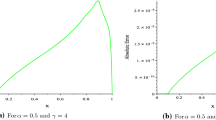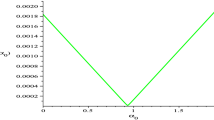Abstract
One of the typical and most significant issues of almost all boundary element analyses is the accurate evaluation of nearly singular boundary element integrals. In this study, we review some numerical techniques used currently to calculate nearly singular integrals and propose an improved algorithm to calculate integrals with nearly strong (and beyond) singularities. This new method has full generally and can be easily included in any existing computer code. The method is tested in general three-dimensional boundary element analysis. Comparison of this method with some of the existing methods is also presented. It is shown that several orders of magnitude improvement in relative errors can be obtained using the proposed method when compared to a straightforward implementation of Gaussian quadrature.









Similar content being viewed by others
References
Cheng AHD, Cheng DT (2005) Heritage and early history of the boundary element method. Eng Anal Bound Elem 29(3):268–302
Takahashi T (2014) An interpolation-based fast-multipole accelerated boundary integral equation method for the three-dimensional wave equation. J Comput Phys 258:809–832
Aimi A, Diligenti M, Guardasoni C (2016) Energetic BEM–FEM coupling for the numerical solution of the damped wave equation. Adv Comput Math 1–25. doi:10.1007/s10444-016-9500-1
Sladek V, Sladek J, Tanaka M (1993) Regularization of hypersingular and nearly singular integrals in the potential theory and elasticity. Int J Numer Methods Eng 36(10):1609–1628
Ma H, Kamiya N (2002) Distance transformation for the numerical evaluation of near singular boundary integrals with various kernels in boundary element method. Eng Anal Bound Elem 26(4):329–339
Lv J, Miao Y, Zhu H (2014) The distance sinh transformation for the numerical evaluation of nearly singular integrals over curved surface elements. Comput Mech 53(2):359–367
Xie G, Zhang J, Dong Y, Huang C, Li G (2014) An improved exponential transformation for nearly singular boundary element integrals in elasticity problems. Int J Solids Struct 51(6):1322–1329
Zhou HL, Niu ZR, Cheng CZ, Guan ZW (2008) Analytical integral algorithm applied to boundary layer effect and thin body effect in BEM for anisotropic potential problems. Comput Struct 86(15):1656–1671
Nagarajan A, Mukherjee S (1993) A mapping method for numerical evaluation of two-dimensional integrals with 1/r singularity. Comput Mech 12(1–2):19–26
Guiggiani M, Gigante A (1990) A general algorithm for multidimensional Cauchy principal value integrals in the boundary element method. J Appl Mech 57(4):906–915
Sladek V, Sladek J (1992) Non-singular boundary integral representation of stresses. Int J Numer Methods Eng 33(7):1481–1499
Karageorghis A, Fairweather G (1987) The method of fundamental solutions for the numerical solution of the biharmonic equation. J Comput Phys 69(2):434–459
Lachat JC, Watson JO (1976) Effective numerical treatment of boundary integral equations: a formulation for three-dimensional elastostatics. Int J Numer Methods Eng 10(5):991–1005
Gao XW, Yang K, Wang J (2008) An adaptive element subdivision technique for evaluation of various 2D singular boundary integrals. Eng Anal Bound Elem 32(8):692–696
Gao X-W (2006) Numerical evaluation of two-dimensional singular boundary integrals—theory and Fortran code. J Comput Appl Math 188(1):44–64
Padhi GS, Shenoi RA, Moy SSJ, McCarthy MA (2001) Analytic integration of kernel shape function product integrals in the boundary element method. Comput Struct 79(14):1325–1333
Niu ZR, Cheng CZ, Zhou HL, Hu ZJ (2007) Analytic formulations for calculating nearly singular integrals in two-dimensional BEM. Eng Anal Bound Elem 31(12):949–964
Lutz E (1992) Exact Gaussian quadrature methods for near-singular integrals in the boundary element method. Eng Anal Bound Elem 9(3):233–245
Gu Y, Hua Q, Chen W, Zhang C (2016) Numerical evaluation of nearly hyper-singular integrals in the boundary element analysis. Comput Struct 167:15–23
Hayami K (2005) Variable transformations for nearly singular integrals in the boundary element method. Publ Res Inst Math Sci 41(4):821–842
Hayami K, Matsumoto H (1994) A numerical quadrature for nearly singular boundary element integrals. Eng Anal Bound Elem 13(2):143–154
Telles JCF (1987) A self-adaptive co-ordinate transformation for efficient numerical evaluation of general boundary element integrals. Int J Numer Methods Eng 24(5):959–973
Huang Q, Cruse TA (1993) Some notes on singular integral techniques in boundary element analysis. Int J Numer Methods Eng 36(15):2643–2659
Sladek V, Sladek J, Tanaka M (2000) Optimal transformations of the integration variables in computation of singular integrals in BEM. Int J Numer Methods Eng 47(7):1263–1283
Ma H, Kamiya N (2002) A general algorithm for the numerical evaluation of nearly singular boundary integrals of various orders for two- and three-dimensional elasticity. Comput Mech 29(4):277–288
Xie G, Zhou F, Zhang J, Zheng X, Huang C (2013) New variable transformations for evaluating nearly singular integrals in 3D boundary element method. Eng Anal Bound Elem 37(9):1169–1178
Xie G, Zhang J, Qin X, Li G (2011) New variable transformations for evaluating nearly singular integrals in 2D boundary element method. Eng Anal Bound Elem 35(6):811–817
Johnston BM, Johnston PR, Elliott D (2007) A sinh transformation for evaluating two-dimensional nearly singular boundary element integrals. Int J Numer Methods Eng 69(7):1460–1479
Johnston PR, Elliott D (2005) A sinh transformation for evaluating nearly singular boundary element integrals. Int J Numer Methods Eng 62(4):564–578
Gu Y, Chen W, Zhang B, Qu W (2014) Two general algorithms for nearly singular integrals in two dimensional anisotropic boundary element method. Comput Mech 53(6):1223–1234
Gu Y, Chen W, Zhang C (2013) The sinh transformation for evaluating nearly singular boundary element integrals over high-order geometry elements. Eng Anal Bound Elem 37(2):301–308
Zhang Y, Gu Y, Chen J-T (2010) Boundary element analysis of the thermal behaviour in thin-coated cutting tools. Eng Anal Bound Elem 34(9):775–784
Zhang YM, Gu Y, Chen JT (2010) Boundary element analysis of the thermal behaviour in thin-coated cutting tools. Eng Anal Bound Elem 34(9):775–784
Guiggiani M (1991) The evaluation of cauchy principal value integrals in the boundary element method—a review. Math Comput Model 15(3–5):175–184
Guiggiani M, Casalini P (1987) Direct computation of Cauchy principal value integrals in advanced boundary elements. Int J Numer Methods Eng 24(9):1711–1720
Aimi A, Diligenti M, Frangi A, Guardasoni C (2013) Neumann exterior wave propagation problems: computational aspects of 3D energetic Galerkin BEM. Comput Mech 51(4):475–493
Gu Y, Chen W, Zhang C (2013) Stress analysis for thin multilayered coating systems using a sinh transformed boundary element method. Int J Solids Struct 50(20–21):3460–3471
Zhou HL, Niu ZR, Cheng CZ, Guan ZW (2007) Analytical integral algorithm in the BEM for orthotropic potential problems of thin bodies. Eng Anal Bound Elem 31(9):739–748
Aliabadi MH, Martin D (2000) Boundary element hyper-singular formulation for elastoplastic contact problems. Int J Numer Methods Eng 48(7):995–1014
Zhang D, Rizzo FJ, Rudolphi TJ (1999) Stress intensity sensitivities via hypersingular boundary integral equations. Comput Mech 23(5):389–396
Dirgantara T, Aliabadi MH (2000) Crack growth analysis of plates loaded by bending and tension using dual boundary element method. Int J Fract 105(1):27–47
Białecki RA, Dallner R, Kuhn G (1993) Minimum distance calculation between a source point and a boundary element. Eng Anal Bound Elem 12(3):211–218
Johnston BM, Johnston PR, Elliott D (2013) A new method for the numerical evaluation of nearly singular integrals on triangular elements in the 3D boundary element method. J Comput Appl Math 245:148–161
Elliott D, Johnston PR (2007) Error analysis for a sinh transformation used in evaluating nearly singular boundary element integrals. J Comput Appl Math 203(1):103–124
Wu S, Lu P-A (1996) On the evaluation of nearly singular kernel integrals in boundary element analysis—some improved formulations. Commun Numer Methods Eng 12(2):85–93
Zhang YM, Liu ZY, Chen JT, Gu Y (2011) A novel boundary element approach for solving the anisotropic potential problems. Eng Anal Bound Elem 35(11):1181–1189
Acknowledgements
The work described in this paper was supported by the National Basic Research Program of China (973 Project No. 2010CB832702), the National Natural Science Foundation of China (Nos. 11402075, 11302069, 71571108), Projects of International (Regional) Cooperation and Exchanges of NSFC (No. 71411130215), the China Postdoctoral Science Foundation (Nos. 2015M570572, 2015M570569), and the Qingdao Postdoctoral Application Research Project (Nos. 2015138, 15-9-1-49-jch).
Author information
Authors and Affiliations
Corresponding author
Appendix: Determination of the projection point \({\varvec{s}}_{\mathbf {0}} \) and \({\varvec{t}}_{\mathbf {0}} \)
Appendix: Determination of the projection point \({\varvec{s}}_{\mathbf {0}} \) and \({\varvec{t}}_{\mathbf {0}} \)
As previously mentioned, the explicit knowledge of \(s_{0} \) and \(t_{0} \) plays a key role in the present analysis. Their explicit expressions are now derived.
From the definitions of \((s_{0} ,t_{0} )\) and \(r_{0} \) (Figs. 2, 3), the distance function \(r^{2}(s,t)\) will reach the minimum value \(r_{0} \) when \((s,t)\rightarrow (s_{0} ,t_{0} )\). Therefore, according to extreme value theorem, the following relations can be easily obtained
where the derivatives, all evaluated at point \((s_{0} ,t_{0} )\), are promptly obtained from expressions (10) and (13). The problem is now reduced to find the real root \((s_{0} ,t_{0} )\) of the above nonlinear equations system with two variables. Newton’s method and the method of gradients are two most popular numerical methods that are used to solve such nonlinear equations system. Here we focused on the gradient method which solves another equivalent system of equations and obtains new approximations of roots by means of matrix computations. Now we describe the steps of gradients method.
We consider the system of nonlinear algebraic equations
where \((x_{1} ,x_{2} ,\ldots ,x_{n} )\in R^{n}\) and each \(f_{i} \) is a nonlinear real function. Let \(F(x_{1} ,x_{2} ,\ldots ,x_{n} )\) be a function which maps \(R^{n}\) to \(R^{n}\)
Instead of solving the system (39), we are now solving the Eq. (40).
Step 1: Let \({\varvec{x}}^{(0)}=\left( {x_{1}^{(0)} ,x_{2}^{(0)} ,\ldots ,x_{n}^{(0)} } \right) \) be a given initial vector.
Step 2: Calculate \(F\left( {x_{1}^{(0)},x_{2}^{(0)} ,\ldots ,x_{n}^{(0)} } \right) =\sum \limits _{i=1}^n f_{i}^{2} \left( x_{1}^{(0)},\right. \left. x_{2}^{(0)} ,\ldots ,x_{n}^{(0)} \right) .\)
Step 3: Let \(\varepsilon \) be a stopping criterion. If \(F\left( {x_{1}^{(0)} ,x_{2}^{(0)} ,\ldots ,x_{n}^{(0)} } \right) <\varepsilon \), it indicates \(\left( {x_{1}^{(0)} ,x_{2}^{(0)} ,\ldots ,x_{n}^{(0)} } \right) \) is the ‘solution’ to the system. If not, move to Step 4.
Step 4: Calculate \(\left. {\frac{\partial F}{\partial x_{i} }} \right| _{\left( {x_{1}^{(0)} ,x_{2}^{(0)} ,\ldots ,x_{n}^{(0)} } \right) } =2\sum \limits _{j=1}^n {f_{j} \frac{\partial f_{j} }{\partial x_{i} }} ,\left( {i=1,2,\ldots ,n} \right) \), and \(D=\sum \limits _{j=1}^n {\left( {\left. {\frac{\partial F}{\partial x_{i} }} \right| _{\left( {x_{1}^{(0)} ,x_{2}^{(0)} ,\ldots ,x_{n}^{(0)} } \right) } } \right) ^{2}} \) .
Step 5: Using results in Step 4 to find the first iteration \({\varvec{x}}^{(1)}=\left( {x_{1}^{(1)} ,x_{2}^{(1)} ,\ldots ,x_{n}^{(1)} } \right) \) in which
Step 6: Use the results of \({\varvec{x}}^{(1)}\) to find next iteration \({\varvec{x}}^{(2)}\) by using the same procedure. Repeat the process until \(F\le \varepsilon \), which indicates that we have reached the ‘solution’ of the system.
Using the procedure described above, it is now possible to give explicitly the expression of \(r^{2}(s,t)\) in terms of \(s_{0} \) and \(t_{0} \), as shown in Eq. (22). The FORTRAN programs that were used to compute \(s_{0} \) and \(t_{0} \) can be found at: http://blog.sciencenet.cn/blog-425262-950615.html.
Rights and permissions
About this article
Cite this article
Gu, Y., Gao, H., Chen, W. et al. A general algorithm for evaluating nearly strong-singular (and beyond) integrals in three-dimensional boundary element analysis. Comput Mech 59, 779–793 (2017). https://doi.org/10.1007/s00466-016-1372-1
Received:
Accepted:
Published:
Issue Date:
DOI: https://doi.org/10.1007/s00466-016-1372-1




